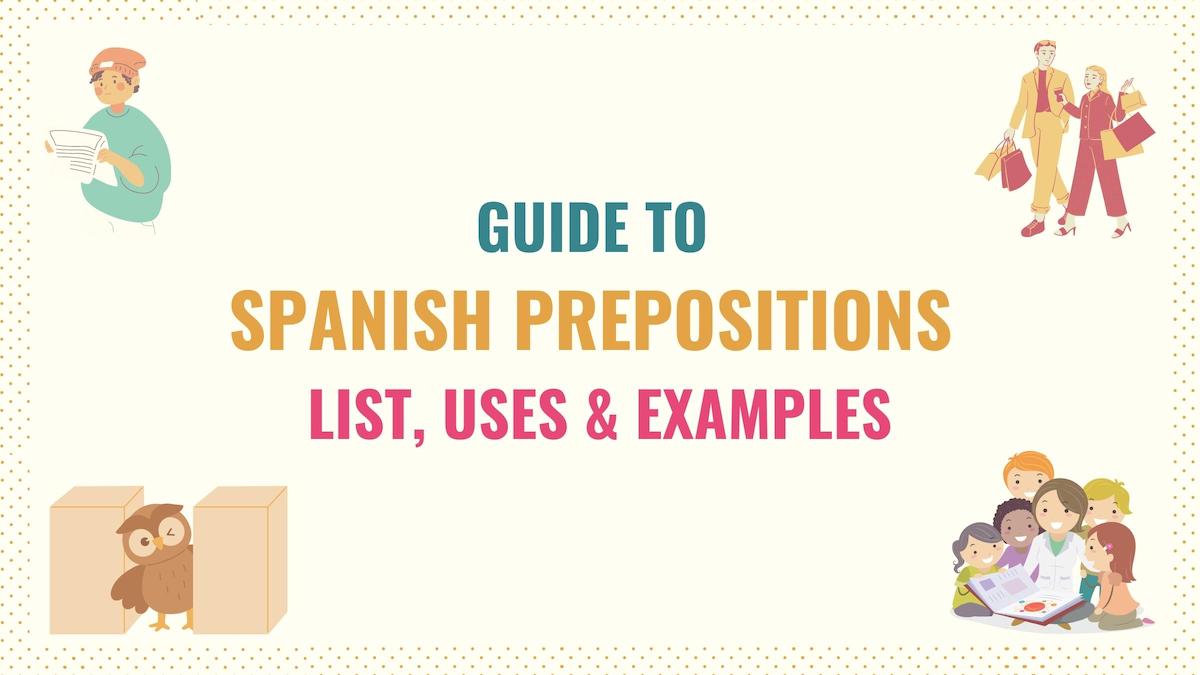Spanish prepositions are essential words that connect nouns or pronouns with other elements while expressing location, time, direction, and more. In short, prepositions are the glue that holds your sentences together, allowing you to form well-structured sentences.
Since these words are crucial for communication, in this guide, we’ll go over:
- List of Prepositions in Spanish
- How & When to Use Prepositions
- Spanish Prepositional Pronouns
- Bonus: Spanish Verbs with Prepositions
- Key Points
- Taking It to the Next Level
Spanish Prepositions List
Here is a list of the most common prepositions in Spanish, their uses, and some examples:
| Preposition | Expresses | English Translation | Example |
|---|---|---|---|
| A | – Direction and destination. – Point in time. – Distance and position. – Personal a. – Means or manner. | To / In / At | Te veo a las 8. See you at 8. |
| Con | – Company. – Means or instruments. | With | Estoy con Carlos. I’m with Carlos. |
| Contra | – Opposition. – Contrast. | Against | Ponla contra la pared. Put it against the wall. |
| De | – Possession. – Origin. – Material. | Of / From | Soy de México. I’m from Mexico. |
| Desde | – Starting point. – Point of departure. | Since / From | Vengo desde París. I come from Paris. |
| Durante | – Duration. – Simultaneity | During / For | Durante el invierno… During winter… |
| En | – Location & Time. – Means of transportation. | In / On / At | Está en la mesa. It’s on the table. |
| Entre | – Location. – Comparisons. – Sharing. | Between | Está entre la mesa y la silla. It’s between the table and the chair. |
| Hacia | – Direction. | Toward / To | Caminamos hacia el bar. We walked toward the bar. |
| Hasta | – Limit. | Until / Up to | Trabajo hasta las 5 de la tarde. I work until 5 in the evening. |
| Para | – Deadline. – Purpose. -Recipient or destination. | For / To | Es para ti. It’s for you. |
| Por | – Cause. – Means. – Amount of time. | For / By / Around / Through | Vine por ti. I came for you. |
| Sin | – Lack of something. | Without | Salí sin dinero. I left without money. |
| Sobre | – Location or position. – Topic or subject. | About / On top of | No hablamos sobre eso. We didn’t talk about it. |
Here are some additional sentences using basic prepositions in Spanish:
Lauren va a la biblioteca.
Lauren goes to the library.
Los niños están en la escuela.
The children are at school.
Vivimos aquí desde mayo.
We’ve lived here since May.
Take Note: According to the Royal Spanish Academy there are 23 prepositions in Spanish. However, the list above contains the prepositions more commonly used.
The list below are the remaining list of prepositions recognized by RAE, but less commonly used in Spanish:
- Ante: Before / Faced with
- Bajo: Under
- Cabe: Only used in compound prepositions
- Mediante: By / With
- Según: According to / As soon as
- So: Under
- Tras: After / Behind
- Versus: Versus / Against
- Vía: Via / By way
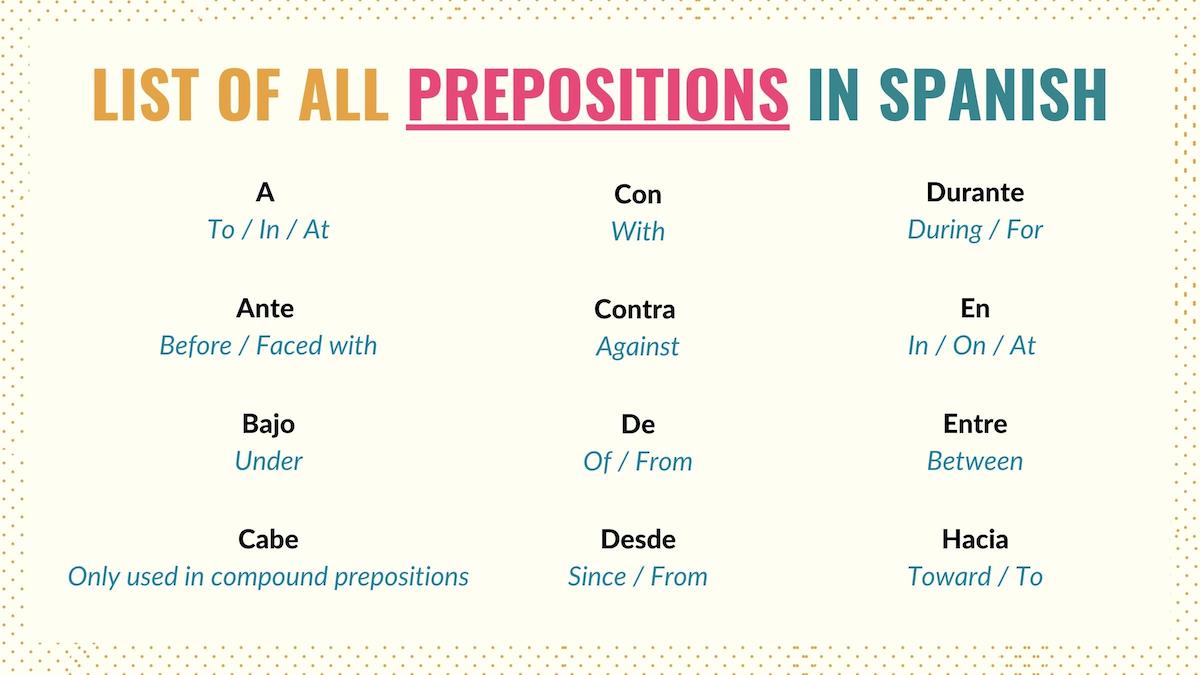
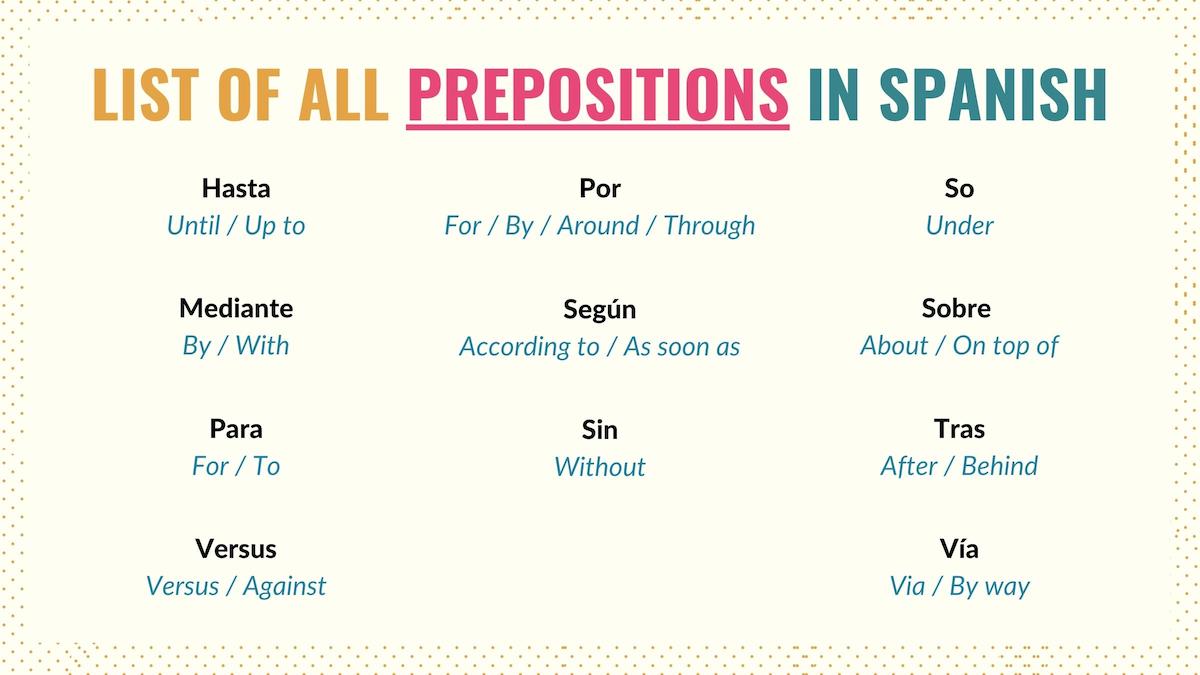
Compound prepositions in Spanish
Compound prepositions, or prepositional phrases, are structures that combine a Spanish preposition with a noun or an adverb. Examples of basic compound prepositions include:
- A pesar de: Despite
- Abajo de: Below / Under
- Al lado de: Next to
- Antes de: Before
- Cabe destacar: It should be noted that
- Cerca de: Nearby / Close
- Detrás de: Behind
- Despues de: After
- En contra de: Opposed to
- En lugar de: Instead of
- En medio de: In the middle of
- Enfrente de: In front of
- Gracias a: Thanks to
- Por encima de: Over / Above
Many of these phrases are used as prepositions of place in Spanish. Here are some examples:
Pude ir gracias a ustedes.
I was able to go thanks to you guys.
Dejé tu cartera al lado de la lámpara.
I left your wallet next to the lamp.
A pesar de todo, acabamos a tiempo.
Despite everything, we finished on time.
How & When to Use Spanish Prepositions
A Spanish preposition is used to connect pronouns or nouns with different elements in the sentence. On top of linking these words, prepositions also express different concepts such as origin, time, location, direction, manner, cause, purpose, introduce an object, etc.
So, we use prepositions to express these relationships. For example:
Emily nació en 1990.
Emily was born in 1990.
El vestido es de seda.
The dress is made of silk.
Me mudé para ahorrar dinero.
I moved out to save money.
¿Qué haces durante el día?
What do you do during the day?
Guillermo y Luz fueron a la farmacia.
Guillermo and Luz went to the pharmacy.
Let’s check the last example. When forming this clause, I need to connect the people with the place to which they’re heading. Since the preposition a in Spanish expresses destination, this is the word I should use to connect the elements of my sentence.
So, you must understand each preposition’s uses to ensure you apply them correctly.
Unlike English, prepositions in Spanish can never be used at the end of a sentence. This is especially important when asking questions. In such cases, prepositions are placed at the beginning of the question:
¿Para qué quieres mis llaves?
Why do you want my keys for?
Take Note: Some prepositions can be easily confused because they share the same translation. That’s the case of por vs para and a vs en. However, each Spanish preposition has a different application. For instance, ‘a’ means ‘at’ when expressing time, whereas ‘en’ means ‘at’ when indicating location.
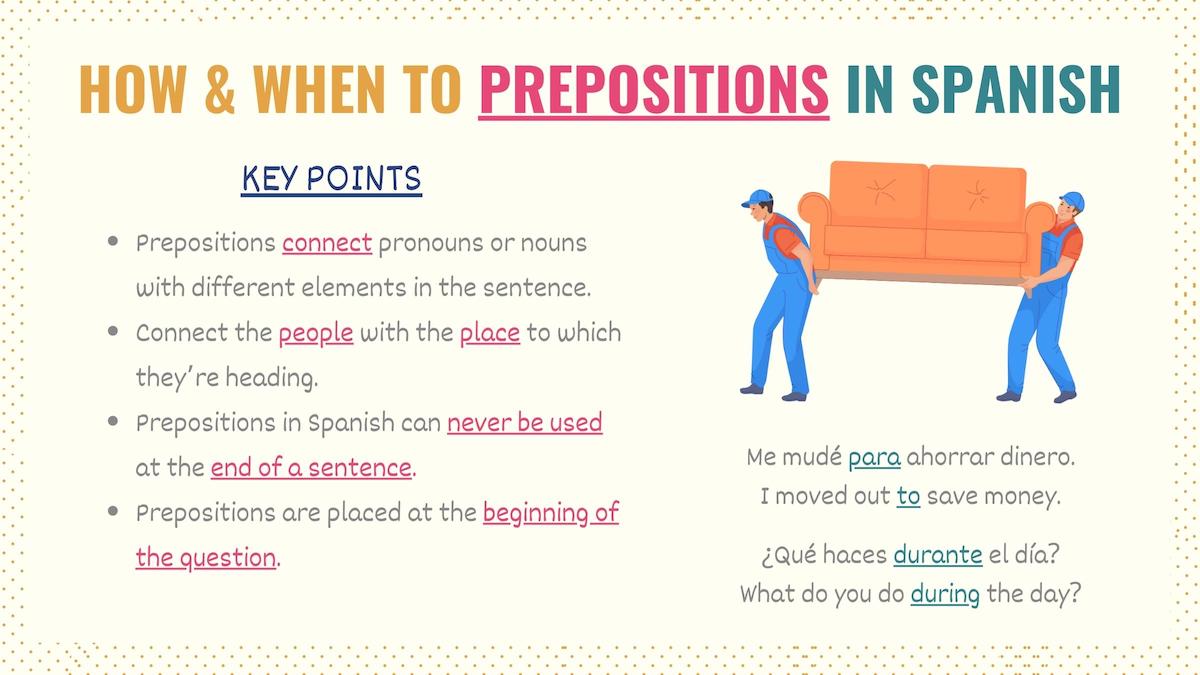
Pronouns After Prepositions in Spanish
As its name suggests, Spanish prepositional pronouns are pronouns which are used after prepositions. For the most part, these pronouns are the same as subject pronouns. However, there are a few exceptions.
Prepositional pronouns in Spanish are:
- Mí: Me
- Ti: You
- Él / Ella / Usted: Him / Her / You
- Nosotros: Us
- Vosotros: You
- Ellos / Ellas / Ustedes: Them / You
Here are some sentences:
El pastel es para mí.
The cake is for me.
Pregúntale a ellos si quieren ir.
Ask them if they want to go.
No se preocupen por nosotros.
Don’t worry about us.
Que se quede entre tú y yo, por favor.
Please, let’s keep this between you and I.
Although the Spanish pronouns above are used with most prepositions, there are some exceptions to keep in mind for mí and ti.
- With the preposition ‘con’, these pronouns become ‘conmigo’ and ‘contigo’.
- Use the subject pronouns ‘yo’ and ‘tú’ with the prepositions ‘entre’, ‘excepto’, ‘salvo’ and ‘según’.
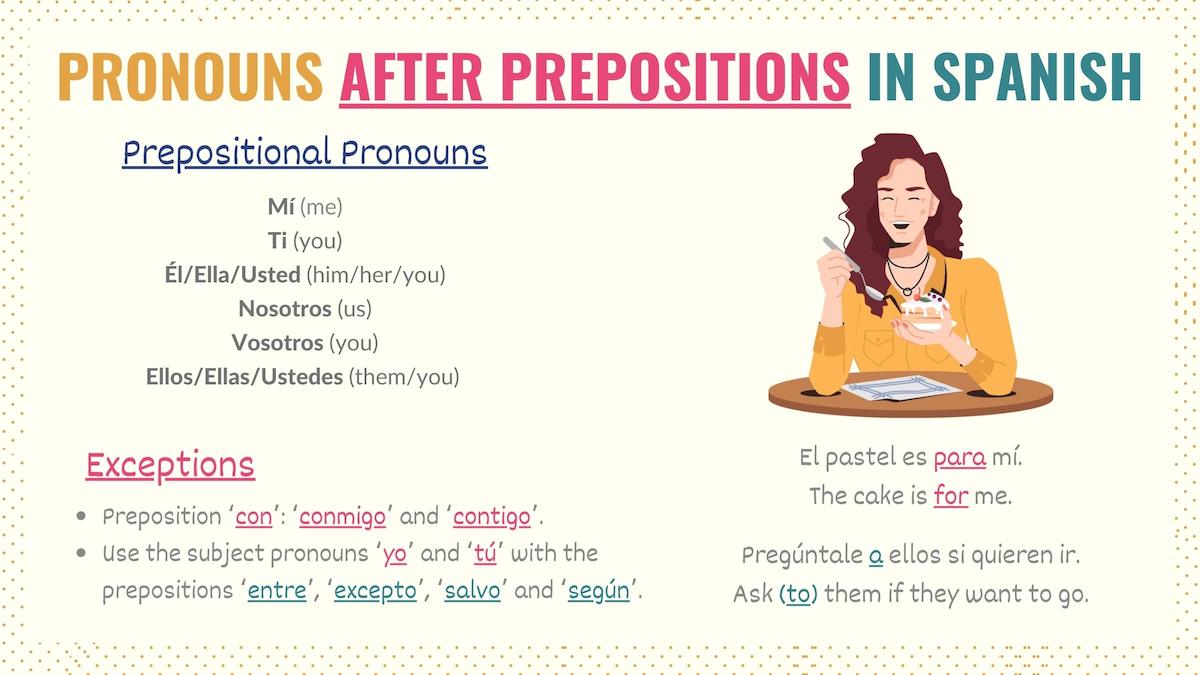
Bonus: Verbs with Prepositions
Many Spanish verbs are often followed by prepositions. Here is a list of common verbs and the prepositions they work with:
- Acabar de: To have just / To finish
- Acordarse de: To remember
- Aprender a: To learn
- Arrepentirse de: To regret
- Ayudar a: To help
- Casarse con: To marry
- Comenzar a: To start
- Confiar en: To trust
- Creer en: To believe
- Dejar de: To stop doing something
- Depender de: To depend on
- Despedirse de: To say goodbye
- Empezar a: To start
- Enamorarse de: To fall in love with
- Encontrarse con: To bump into
- Enseñar a: To teach
- Insistir en: To insist
- Invitar a: To invite
- Ir a: To go to
- Pensar en: To think about
- Ponerse a: To apply yourself to / To start
- Quedar en: To agree / To plan
- Quejarse de: To complain
- Soñar con: To dream about
- Tratar de: To try
- Volver a: To do again
Some of these terms may be followed by nouns or verbs in infinitive form. Here are some examples:
Ellos acabaron de ver la película.
They finished watching the movie.
¿Por qué no invitaste a tus amigos?
Why didn’t you invite your friends?
Julio se casó con mi mejor amiga.
Julio married my best friend.
Alexis aprendió a cocinar cuando era niño.
Alexis learned to cook when he was a kid.
Key Points
Prepositions are an essential part of Spanish grammar. Since they allow you to build well-structured sentences and express the relationship between a noun and other elements, these words are crucial. Here are some key points to remember:
- Prepositions in Spanish connect nouns and pronouns with other elements in the sentence.
- Spanish prepositions express location, time, direction, manner, origin, cause, lack, or company, among other things.
- Some prepositions may express more than one relationship. For instance, ‘a’ conveys direction or time.
- ‘A’, ‘con’, ‘contra’, ‘de’, ‘desde’, ‘durante’, ‘en’, ‘entre’, ‘hacia’, ‘hasta’, ‘para’, ‘por’, ‘sin’, and ‘sobre’ are the most common prepositions in Spanish.
- Compound prepositions are the combination of a preposition, a noun, or adverb.
- In Spanish, prepositional pronouns are the pronouns we use after a preposition.
- Most of these pronouns are no different from subject pronouns. However, ‘yo’ and ‘tú’ have special forms.
Additional Resources for Prepositions in Spanish
Prepositions are one of the nine parts of speech in Spanish. In other words, they’re the building blocks of sentences. Here are some resources that can help you master this topic:
- Desde vs Desde Hace: Desde is a preposition of time in Spanish. In this guide, you’ll learn more about the structures and variations you can use to measure time.
- Personal A: On top of expressing time and movement, the preposition a in Spanish is also used to introduce the direct object of a clause. Since this application doesn’t exist in English and is crucial for proper Spanish, you should check the rules to use personal a.
- Al vs Del: In Spanish, the contractions al and del are very common, but they’re only applied in specific situations. You’ll learn how and when to use these Spanish contractions in this resource.
- How to Use De: De is one of the most common prepositions in Spanish. Click on this resource to find out the different uses of this word.
- Spanish Preposition of Place: In this guide, you’ll learn the prepositions you must use to express where things are located.
Download the List of Spanish Prepositions & Guide PDF
Prepositions are essential for Spanish beginners to learn. As one of the fundamental parts of speech and the glue which connects vital parts of your sentences together, it’s important to have a strong understanding of these Spanish words from the start. Download a free copy of the PDF for this guide, complete with the list of prepositions, graphics, key points and more.

